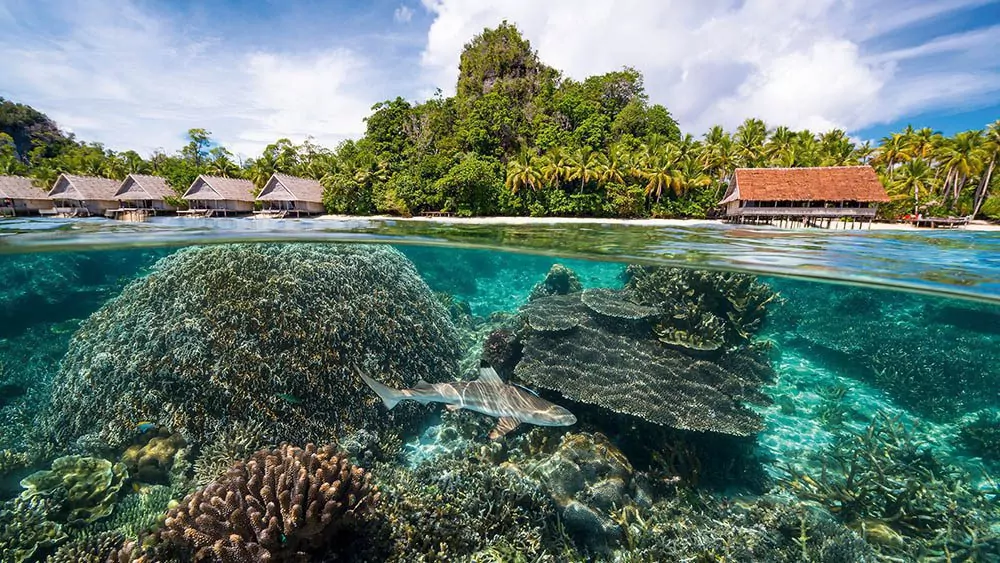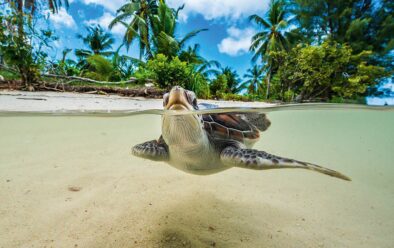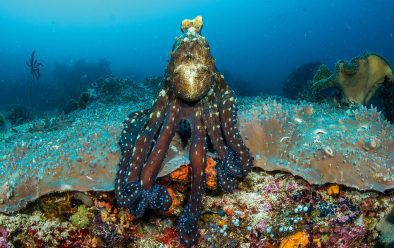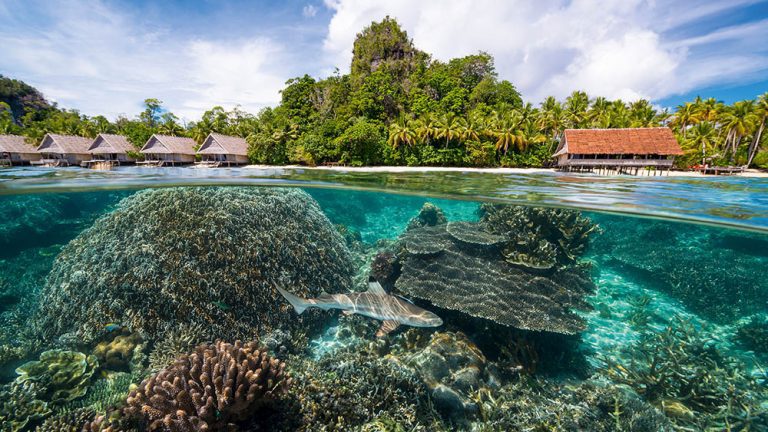INDONESIA DIVER
Raja Ampat in Microcosm
Pef stands a little apart among Raja Ampat islands says THOMAS HAIDER, but he reckons it can offer the best of everything. He wrote the words and took the pictures

View of Raja4Divers from the house reef, including a blacktip reef shark.
THE REMOTE ISLANDS OF Raja Ampat in West Papua have been in big demand with divers ever since marine scientists started describing the area in the heart of the Coral Triangle as the world’s richest eco-system
The abundance and variety of marine life are due to the islands’ position at the crossroads of different oceans. Strong currents converge from all directions, channelling plankton-rich waters into them and protecting the eco-system during El Niño events by flushing it with cooler waters. Species from Indonesia, Philippines and Papua New Guinea are encountered there.
Just don’t expect the sea water always to be clear! The nutrient-rich currents can lead to reduced visibility and also to shifts in water colour from blueish- to greenish, with all the various cyan colour nuances in between.
But it’s this dynamic switching between clear and murky waters that makes this area so interesting for underwater photographers.
Most of the dive-resorts are in the central part of Raja Ampat, and mainly in the Dampier Strait. Pef Island, operated by Raja4Divers, is located a bit off this beaten track, however, north-west of the Dampier Strait, so is more distant from well-known diving spots such as Cape Kri, Sardine Reef and Blue Magic, though they can still be accessed on day-trips.
On the other hand, the celebrated cleaning station Manta Sandy is just a half-hour boat-ride from Pef.
The island lies on the edge of the Raja Ampat underwater shelf, which descends to no more than about 50m depth.
Go west of Pef and you can drop into deeper water. It’s this that gives divers the chance to experience waters that are often clearer than those in the Dampier Strait. The dive-sites are pristine and very “fishy”, with extensive hard- and soft-coral gardens.
Appeared in DIVER June 2018
THE ACCESS TO DEEPER WATER also raises the possibility of seeing whales and feeding-frenzies in open water. During my stay I was lucky to have such an encounter with a Bryde’s whale within sight of the jetty. It was quite tricky to follow a 12m whale feeding on anchovies in the open water, though I finally managed to obtain some decent underwater images.
What makes the area around Pef really special is the possibility of diving in so many different habitats. Signature Raja Ampat dives such as the Blue Water Mangroves of Yembraimuk, the Passage and Hidden Bay are just around the corner, so where other resorts have to make a full day-trip, from Pef you can get there easily for a single dive.
The entrance to Hidden Bay is a narrow, twisting fjord that leads into an extensive mangrove area. In the middle is a huge bay surrounded by typical karst islands. Steep cliffs and rocky islands covered in lush vegetation protrude from the sea like mushrooms, and a huge labyrinth of waterways cut through this fantastic landscape.

You can easily see the seabed from the dive-boat. During high tides ocean water flushes all these mangrove areas, and the water is so clear that you can see the fish and corals even before diving.
This is the perfect time to snorkel or dive between the mangrove roots and watch schools of juvenile fish, particularly cardinalfish and the archerfish that can shoot down insect prey with a jet of water emitted from the mouth.
Due to this permanent flushing with nutrient-rich water the stilt roots of the mangroves are covered with colourful sponges and sea-squirts, and even soft corals and seafans.
If you like currents and action the Passage, a strait between the islands of Gam and Waigeo, is one of the most unusual of experiences, not unlike a river dive and with two caves to explore.
One of these caves opens on top, allowing divers to ascend to the surface – in the middle of the jungle!
The current is always very strong in the strait. Scattered along the passage are small bays and rocks that can be used as shelter, and you can find a lot of macro stuff there, only don’t forget to look out into the strait, because almost any pelagic animal could be passing by.
The little bays are covered by rainforest canopy. If there is sunshine, stay in the area and a mystical, even spooky atmosphere can develop as small gaps in the dense foliage bathe the rainbow-coloured soft corals, gorgonians, sponges and sea-squirts just beneath the surface with shafts of light.
The result is a scene of absolute tranquillity – it’s Raja Ampat at its best, and you will never forget the impression it makes.
On day-trips to the Fam Islands you can dive Melissa’s Garden, which has one of the biggest table-coral aggregations I have ever seen. Clouds of damselfish hover above and hide in the branches of the acropora corals.
Out of the water you can also climb a hill to a platform that offers a breath-taking view over a lagoon, with its typical mushroom-shaped limestone rocks.
DIVING AT PEF’S house reef is very convenient, because the diving-equipment room is located right above the coral reef at the end of the jetty, so you need only take one big step to access the water. Just a few metres from the jetty the main coral reef plunges to 30m, and a ridge leads away from it at a 90° angle towards a plateau.
Being so close to deeper water, this area is full of fish and densely packed with hard and soft corals, leather corals, seafans and anemones.
With ao many wide-angle attractions it’s easy to forget to look into the corals, but they host many macro creatures.

Between the pillars of the jetty, many different species of fish seek shelter. Batfish are among them, and even long-jaw mackerel can be observed zig-zagging around the jetty, mouths wide open as they feed on the plankton.
When the weather is rough around Pef you can dive in a sheltered area behind the island. These are not only macro sites but harbour many fish, including a resident school of barracuda. There is also an extensive field of huge elephant-ear sponges in yellow and violet colours.
There is nothing simple about Pef, because it offers a combination of coconut-fringed beaches, coral reefs, limestone rocks, lagoons, bays, waterways, mangroves, rainforest containing a hidden lake and an ancient rock painting. As such, it assembles Raja Ampat’s topography all in one place.
ITS NATURE GIVES RISE TO activities besides scuba-diving, such as climbing, exploring the rainforest, birding, kayaking and snorkelling. Some parts of the island offer hiking opportunities and wild-animal encounters. Monitor lizards populate the boardwalk to the bungalows.
Maya Hadorn, the Swiss owner of Raja4Divers, was able to rent Pef Island for 50 years, and the resort is designed for up to 18 guests. The 10 over-water stilted bungalows are built with local materials, and all face west so that guests can enjoy the sunsets from their verandas. There is no air-conditioning, just a big ceiling fan.
The power supply is shut down between midnight and 5.30am, so it can get hot under the mosquito net but I didn’t find this a problem because the bungalows are so big.
The small number of guests at the resort allows for both privacy and a friendly atmosphere as desired, helped by family-style eating at one long table in the over-water restaurant – look down and you’ll see blacktip sharks cruising around the pillars.
The combination of western and Indonesian-style food is sumptuous and makes much use of local produce.
For each bungalow Raja4Divers provides an iPad containing interesting apps, including ones for fish ID, tides and star-gazing. Underwater photographers benefit from a well-equipped climate-controlled camera room, including a large-screen iMac on which to view
their work.
Maya’s passion and enthusiasm is reflected in all aspects of what she calls her “little village”. For example, she has established her own carpenter’s shop, featuring the creativity of the local people, and you can also enjoy their artistry under water.
Beneath the jetty a group of concrete sculptures portray a family preparing a meal – and quickly becoming covered in corals and sponges.
The owner’s personality, her friendly, cheerful staff, the breathtaking beauty and diversity of this Garden of Eden island and the exceptional diving in many different habitats are the ingredients of success – as reflected by a notably high rate of returning guests.
Thomas Haider’s photographs are part of a long-term project on the seascape of West Papua, supported by Subal Underwater Housings (subal.com)
FACTFILE
GETTING THERE> Garuda now flies direct from London to Jakarta. Continue with Lion Air/Batik Air/Wings Group or Garuda Indonesia to Sorong. With Garuda you can check through from London with an additional 23kg weight allowance for dive gear. The boat to Pef takes 3.5 hours.
LIVEABOARD> Raja4Divers offers more than 60 sites, a maximum of eight divers per boat and a guide for every four divers. Free nitrox, 10 water bungalows for 1-4 people, raja4divers.com
WHEN TO GO> There are no thermal seasons but sun, wind and waves can change daily because Pef is so close to the Equator.
MONEY> Raja4Divers can’t take credit cards but accepts Indonesian rupiah, euros or US dollars.
PRICES> One week full-board (two sharing), airport transfer, last night hotel in Sorong and unlimited diving costs £2150. Return flights around £750. Packages with flights available from Dive Worldwide.
VISITOR Information> indonesia.travel

